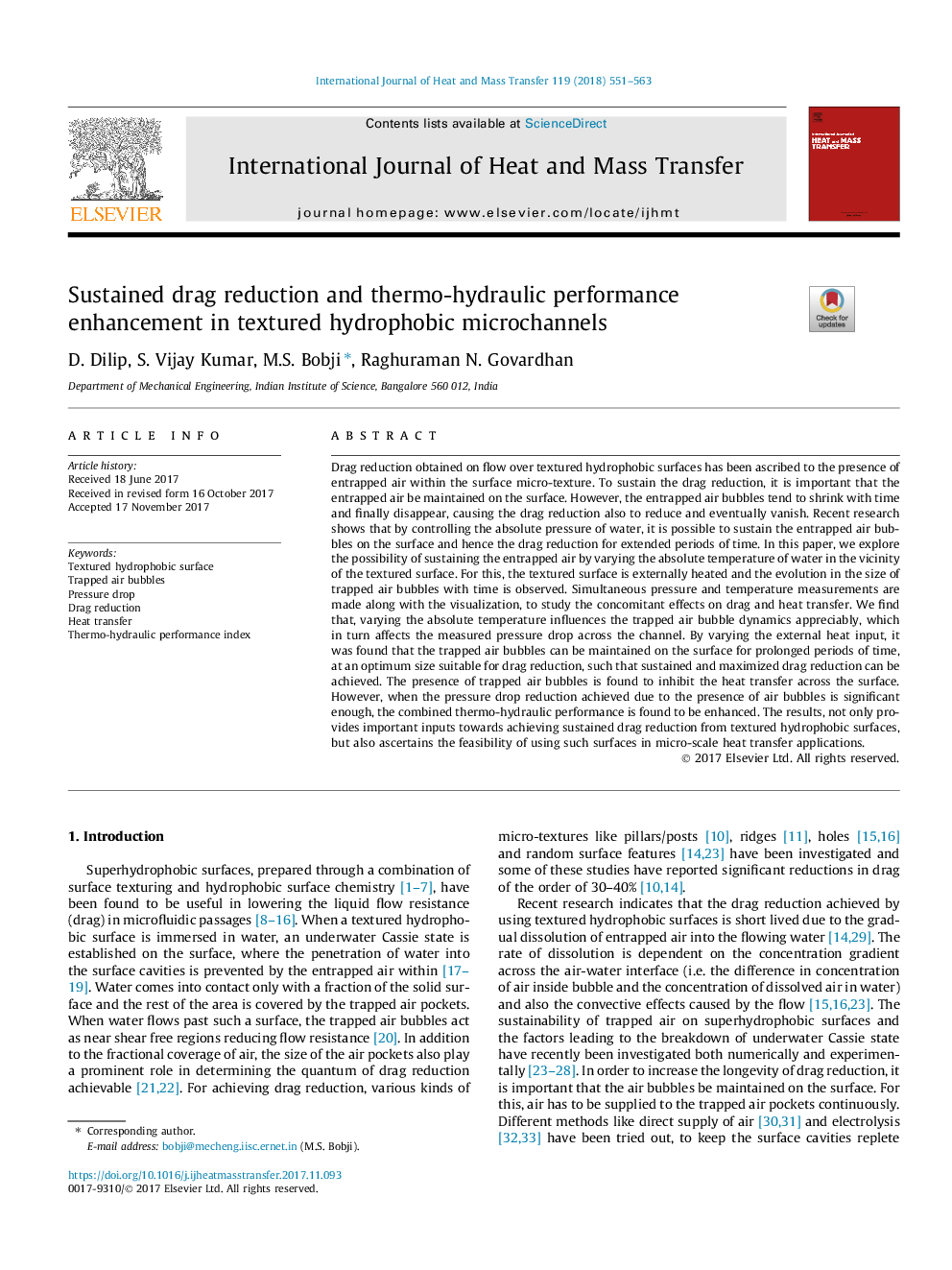| کد مقاله | کد نشریه | سال انتشار | مقاله انگلیسی | نسخه تمام متن |
|---|---|---|---|---|
| 7054698 | 1458021 | 2018 | 13 صفحه PDF | دانلود رایگان |
عنوان انگلیسی مقاله ISI
Sustained drag reduction and thermo-hydraulic performance enhancement in textured hydrophobic microchannels
ترجمه فارسی عنوان
کاهش کششی پایدار و افزایش کارایی ترمو هیدرولیک در میکرو کانال های هیدروفوبیک بافت
دانلود مقاله + سفارش ترجمه
دانلود مقاله ISI انگلیسی
رایگان برای ایرانیان
کلمات کلیدی
سطح هیدروفوبیک بافت حباب های هواپیما گرفتار، افت فشار، کاهش کشیدن، انتقال گرما، شاخص عملکرد ترمو هیدرولیک،
ترجمه چکیده
کاهش کشش حاصل شده در جریان بیش از سطوح هیدروفوبیک بافت، به دلیل حضور هوا درون میکرو بافت سطح است. برای حفظ کاهش کشیدن، مهم است که هوا درگیر در سطح نگه داشته شود. با این حال، حباب های هوای ورودی تمایل دارند با زمان کاهش یابد و در نهایت ناپدید می شوند، باعث می شود کاهش کشیدن نیز کاهش یابد و در نهایت ناپدید شود. تحقیقات اخیر نشان می دهد که با کنترل فشار مطلق آب، ممکن است حباب های هوا وارد شده روی سطح را حفظ و از این رو کاهش کشیدن برای مدت زمان های طولانی. در این مقاله، ما امکان بررسی هوای ورودی را با تغییر درجه حرارت مطلق آب در مجاورت سطح بافتی بررسی می کنیم. برای این، سطح بافتی به صورت خارجی گرم می شود و تکامل در اندازه حباب های هوا به دام افتاده با زمان مشاهده می شود. اندازه گیری های فشار و دما همزمان با تصویربرداری صورت می گیرد، برای بررسی اثرات همزمان کشیدن و انتقال حرارت. ما دریافتیم که تغییر درجه حرارت مطلق بر پویایی حباب هوای به دام افتاده تاثیر می گذارد، که به نوبه خود بر کاهش فشار اندازه گیری شده در کانال تأثیر می گذارد. با تغییر دادن ورودی گرما خارجی، متوجه شدیم که حباب های سقوط شده را می توان در طول دوره های طولانی مدت نگهداری کرد، در یک اندازه بهینه برای کاهش کشیدن، به طوری که می توان کاهش کششی پایدار و حداکثر می شود. حضور حباب های سقوط شده حاکی از آن است که انتقال حرارت را در سرتاسر سطح مانع می شود. با این حال، هنگامی که کاهش افت فشار به دلیل حضور حباب های هوا به اندازه کافی قابل توجه است، عملکرد ترکیب حرارتی هیدرولیک افزایش می یابد. نتایج، نه تنها فراهم می کند مهم برای دستیابی به کاهش کشیدن پایدار از سطوح هیدروفوبیک بافت، بلکه امکان استفاده از چنین سطوح در برنامه های کاربردی انتقال حرارت در مقیاس کوچک را نشان می دهد.
موضوعات مرتبط
مهندسی و علوم پایه
مهندسی شیمی
جریان سیال و فرایندهای انتقال
چکیده انگلیسی
Drag reduction obtained on flow over textured hydrophobic surfaces has been ascribed to the presence of entrapped air within the surface micro-texture. To sustain the drag reduction, it is important that the entrapped air be maintained on the surface. However, the entrapped air bubbles tend to shrink with time and finally disappear, causing the drag reduction also to reduce and eventually vanish. Recent research shows that by controlling the absolute pressure of water, it is possible to sustain the entrapped air bubbles on the surface and hence the drag reduction for extended periods of time. In this paper, we explore the possibility of sustaining the entrapped air by varying the absolute temperature of water in the vicinity of the textured surface. For this, the textured surface is externally heated and the evolution in the size of trapped air bubbles with time is observed. Simultaneous pressure and temperature measurements are made along with the visualization, to study the concomitant effects on drag and heat transfer. We find that, varying the absolute temperature influences the trapped air bubble dynamics appreciably, which in turn affects the measured pressure drop across the channel. By varying the external heat input, it was found that the trapped air bubbles can be maintained on the surface for prolonged periods of time, at an optimum size suitable for drag reduction, such that sustained and maximized drag reduction can be achieved. The presence of trapped air bubbles is found to inhibit the heat transfer across the surface. However, when the pressure drop reduction achieved due to the presence of air bubbles is significant enough, the combined thermo-hydraulic performance is found to be enhanced. The results, not only provides important inputs towards achieving sustained drag reduction from textured hydrophobic surfaces, but also ascertains the feasibility of using such surfaces in micro-scale heat transfer applications.
ناشر
Database: Elsevier - ScienceDirect (ساینس دایرکت)
Journal: International Journal of Heat and Mass Transfer - Volume 119, April 2018, Pages 551-563
Journal: International Journal of Heat and Mass Transfer - Volume 119, April 2018, Pages 551-563
نویسندگان
D. Dilip, S. Vijay Kumar, M.S. Bobji, Raghuraman N. Govardhan,
